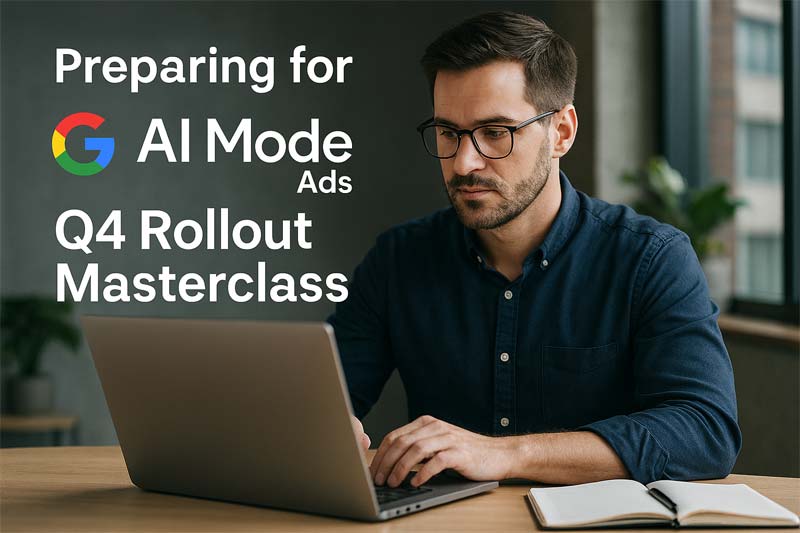In this comprehensive master‑class, discover how Google briefs brands on deploying AI Mode ads ahead of a major Q4 rollout. Learn what AI Mode ads are, why they’re a paradigm shift in Google advertising, and how agencies and brands can adapt effectively. This course is perfect for marketers, SEO professionals, e‑commerce brands, and PPC strategists looking to stay ahead of the AI‑powered future of search.
Introduction to Google AI Mode & Q4 Ad Rollout
- What is AI Mode?
Google’s AI Mode is a conversational‑search interface powered by Gemini AI, introduced in May and now live in markets including the U.S., India, and the U.K. - Why Q4 matters:
With the broader ad rollout planned before Q4 2025, this is Google’s pivotal push into monetizing AI‑powered search. Early adopters gain a competitive edge. - Brand briefings:
Google circulated an internal slide deck titled “Ads in AI Mode” to brands and agencies, explaining how ads will function and differ from traditional search ads.
Key Features of AI Mode Ads
Conversation-Based Targeting vs Keyword-Based
- Shift from keywords to dialogue:
Ads will be triggered by the entire AI conversation context rather than isolated search keywords, marking a dramatic shift for search marketing. “The big shift is from queries to conversations.” - Exploratory intent:
Queries are longer and more exploratory in AI Mode, giving brands new opportunities to appear when users are researching, not just searching.
Ad Formats Supported
- Text ads:
Similar in format to classic Google Search ads—clean, annotated as “Sponsored.” - Shopping ads:
These include images, pricing, and product info, pulled from product feeds.
Campaign Types & Automation Tools
- Performance Max & AI Max for Search:
Campaigns running through these automated solutions will automatically be eligible to appear in AI Mode results. - Feed hygiene:
Fresh, accurate product data is essential. Brands with stale or incomplete feeds may get excluded. - AI-powered creative tools:
Google is also allowing advertisers to generate visuals via Veo and Imagen, and optimizing bids using Smart Bidding Exploration.
Strategic Planning for Q4
Preparing Your Brand Infrastructure
- Audit your product feed: ensure titles, images, prices, availability are accurate.
- Align campaigns to broad match or Performance Max to enable AI Mode delivery.
- Leverage AI creative tools to match the multi-modal nature of AI Mode.
Messaging & Landing Page Optimization
- Prioritize unique, valuable content, optimized for conversational search.
- Support content with high-quality images/videos to satisfy multi modal context.
- Make sure content is crawl-able and index-able—Google requires technical access to understand context.
Monitoring Performance
- Watch for changes in click-through rates, as AI Overviews and AI Mode can reduce organic visits.
- Start analyzing CPM vs CPC models—with AI Mode ads, impressions may matter more than traditional clicks.
Measuring & Optimizing ROI
Key Metrics to Track
- Impression-based metrics: cumulative reach in AI conversations.
- Conversion performance from ad-engaged sessions.
- Feed health metrics: feed rejection rate, accuracy score.
- Engagement quality: time on site, scroll depth, form completions.
Optimization Best Practices
- Continuously refresh product feed; synchronize price, availability, and structured data.
- Iterate ad messaging based on conversational triggers (exploratory queries vs transactional).
- Use Smart Bidding and creative A/B tests to refine campaign strategies.
Industry Challenges & Risks
Brand Safety & Transparency
- Google faces regulatory scrutiny over ad-tech dominance; brands are wary about transparency in ad placements.
- Disclosure: AI‑generated ads will be clearly labeled as “Sponsored.”
Audience Behavior Shifts
- Users may rely solely on AI Mode summaries, bypassing destination websites. This could reduce traditional site traffic.
- Advertisers need to weigh impression CPM value against CTR‑based CPA models.

Reference
For best practices in on‑page SEO, keyword research, meta tag optimization, and content audit tools, check our guide on Small‑SEO‑Tool: Indeed recommend linking to internal relevant pages like ‘/seo‑audit‑tool’ or others—e.g.:
→ Learn how to audit your content and optimize metadata effectively.
Google AI Mode ads, AI Mode advertising, Google ad rollout Q4, Performance Max AI ads, conversational search targeting, feed hygiene, AI search marketing
FAQs (Frequently Asked Questions)
Q1: What exactly changes with ads in Google AI Mode versus traditional search ads?
A: Rather than matching ads to specific keywords, AI Mode matches ads to entire conversation context—taking into account user intent throughout the chat interaction rather than only user input.
Q2: When will the broader rollout actually begin?
A: Google briefed brands in early August 2025—rollout is expected to accelerate before Q4 2025. Partial access already exists for some users in select markets including India, the U.S., and the UK.
Q3: Do I need a new campaign type for AI Mode ads?
A: You don’t need separate campaigns—existing Performance Max or AI Max for Search campaigns will automatically serve ads in AI Mode if targeting and feed criteria are met.
Q4: How critical is feed hygiene, and what exactly qualifies?
A: Critical. Google’s document emphasizes accurate and updated product catalogs with correct prices, images, descriptions, and structured data. Poor feed hygiene may block serving in AI Mode.
Q5: Will this reduce clicks to my website?
A: Possibly—AI Overviews and conversational answers sometimes satisfy users without requiring a click. Advertisers must track both impression‑based ROI and conversions.
Summary & Next Steps
- Understand the shift: Google is moving from query‑based to conversation‑based ad targeting.
- Ensure your campaigns are AI‑ready: Use Performance Max or AI Max for Search, with clean product feeds.
- Prioritize creative & content quality: Optimize for multimodal, conversational interfaces.
- Plan for Q4 season: With rollout accelerating before the holiday season, early adaptation can drive critical visibility.
By following this AI Mode Ads Masterclass, marketers and brands can confidently prepare for Google’s next‑gen ad ecosystem. Combine this strategy with strong SEO practices—on‑page optimization, internal linking, structured data—to stand out both organically and in AI‑driven paid channels.
If you’d like help leveraging these insights to audit your site or improve your ad strategy, check our suite of tools and SEO educational resources at small‑seo‑tool.com, and explore the SEO audit tool here for optimizing your landing pages and metadata.


